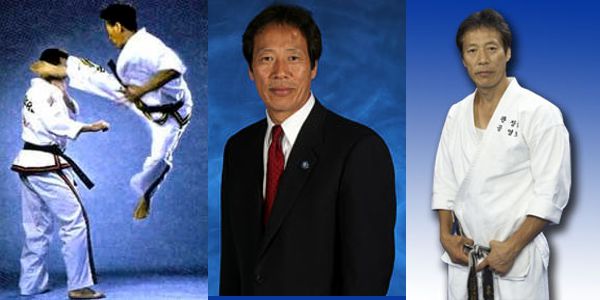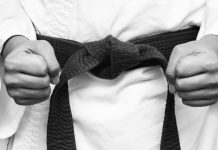Tae Kwon Do Grand Master Young Bo Kong has been called the fastest kicker alive. However, even with his speed, this two-time national champion stresses the importance of being able to set up an opponent for an attack regardless of how fast your kicks are.
“Speed is very important, and if you are faster than your opponent he will probably not be able to stop you,” says Grand Master Kong. “But speed is not everything. You must use excellent technique and you must be able to create an opening for those techniques to score.”
After more than 40 years in the martial arts Grand Master Kong continues to land his kicks and punches with blinding-fast speed, but it is the way in which he sets up his attacks that truly overwhelms his opponents. Once the 8th degree black belt “fakes” his adversary into the desired position Grand Master Kong’s quickness takes over and in the blinking of an eye his foot or fist is expertly guided to its target. One of the ways he teaches his students to accomplish what he has mastered is by showing them how to read or anticipate their opponent.
“At the start of the match it’s important to get a “read” on your opponent,” says Grand Master Kong. “It’s a good idea to find out how he or she will attempt to counter a kick or punch. One of the ways we do this In Taekwon-do is to bounce up and down while throwing some “faints” at our opponent. By doing this you can see how they will react and this can give you an idea of how to set up your attack for a score. For example, I might flip a kick to the body to see if my opponent will respond by moving back, to the side, or with a block. If they lower their guard I know they can be set up for a roundhouse kick to the head. If they back off I know I can set them up for a spinning back kick. Then you test their defense by throwing a punch or backfist to the head. If they are quick to raise both hands you now know how to set them up for an attack to the ribs.”
One of the most exciting techniques in Taekwon do is the Axe kick. Although it may be poetry in motion to watch, to be on the receiving end of this powerful blow is something all competitors try to avoid. However because of the very nature of the kick, if executed properly the technician is likely to receive high marks from the judges while putting the fear of Taekwon do into the heart of his or her opponent.
“The Axe kick can be very powerful if done properly,” says Grand Master Kong. “You should hit your target with the ball of your foot or the bottom of your heel. Some people try to use the bottom of the foot, which causes them to reach out too far and that weakens the effectiveness of the kick and puts the kicker off balance. You should try to hit with the heel as that will be more devastating, but it also requires a greater level of skill.”
Because of its lethal power the Axe kick must be used with great restraint and control. One of the ways the Axe kick can be life threatening is if you land your heel on someone’s temple, eye or bridge of their nose. If the kick connects squarely on an individual’s neck or back of the spine it could cause neurological damage or even death. Even a blow to the solar plexus could be fatal as such a blow might break ribs, puncturing a lung or even damage the heart. While the Axe kick is one of the most devastating techniques in the Taekwon do arsenal, it’s also one of the most difficult kicks to master.
According to Grand Master Kong one of the most common errors students make when using an Axe kick is in understanding where the power of the kick originates. For an Axe kick to land with the desired effect and total power the kicker must first recognize that the leg is merely the messenger, the part of the body sending the message is the abdomen.
“So many people think the power of the kick comes from the leg; that is not so with the Axe kick,” says Grand Master Kong. “It is the downward “snapping” action of the stomach that gives power and speed to this kick. If you use just your leg strength the kick will be weak and most likely will fall short of its mark. You must extend your upper body giving length and power to the kick. By contrast, if you’re only using your leg to control the kick and you and miss, the kick will fall downward into the floor forcing you off balance. But if you are using the stomach or upper body as the kicks power source the technique can be controlled. That way, should you miss, your balance will be centered allowing you to change up to different kick (like a hooking kick) without ever sitting your foot down.”
Once you’ve perfected the technical applications of the Axe kick the next step is to create an opening in which it can be used effectively.
“One of the methods I like to use to set my opponent up for an Axe kick is to fake with a low front kick causing them to lower their guard for the block,” Grand Master Kong explains. “Next I bring the kick up over their block and kick them either the head, shoulder or stomach. To effectively “fake” out your opponent first raise your knee as if you were going to deliver a kick to their midsection. The goal of this move is to get your opponent to watch your knee. There are two objectives the kicker must accomplish to make this set up work. One is to “sell” the move, drive the knee up high and push it out a bit; this gives the appearance of intent to commit to a snap or thrust kick. Second, be patient. Wait until your opponent takes the bait before showing your hand. Then when they bend or move forward to block the suspected kick, and only then, you change up to an Axe kick and drive it downward for the score.”
However effective the Axe kick may be, it also has its drawbacks. If it isn’t set up or executed with near-perfect precision, this technique can be easily blocked, thus putting the attacker in a very vulnerable position for a variety of counters.
“To counter the Axe kick good timing is very important,” says Grand Master Kong. “One of my favorite ways to attack the Axe kick is by rushing in and jamming the leg with my body and countering with a punch to the chest or head. I also like to sweep my opponents leg out from under him. Many years ago it was okay to use a sweeping technique in a tournament but it is not allowed today. However, the sweeping technique is an excellent self defense technique.”
Grand Master Kong was very candid in admitting that the Axe kick isn’t his favorite kick, but he was also quick to point out that there is no such thing as a bad kick. Success in kicking comes from much practice and in understanding the strengths and limitations of each kick. In order to execute a kick for points or combat, the martial artist must also know how to position his opponent to make him or her vulnerable to that attack without subjecting themselves to a counter attack.
“Whether it’s being used in the street or in a sporting tournament, it’s important to know how to set your opponent up for the kick,” says Grand Master Kong. “It doesn’t matter how you do it, but for maximum results (for the Axe kick) you must get your opponent to lower his guard and to lean backwards. When he is in that position he has no balance making him a perfect target for an Axe kick. The difference is, in a tournament you walk home with a trophy, in the street you walk home with your life.”







